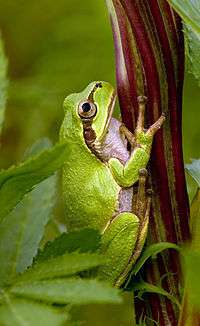Japanese tree frog
| Japanese tree frog | |
|---|---|
 | |
| Scientific classification | |
| Kingdom: | Animalia |
| Phylum: | Chordata |
| Class: | Amphibia |
| Order: | Anura |
| Family: | Hylidae |
| Genus: | Hyla |
| Species: | H. japonica |
| Binomial name | |
| Hyla japonica Günther, 1859 | |
The Japanese tree frog (Hyla japonica) is a species of tree frog distributed from Hokkaidō to Yakushima in Japan and from Korea along the Ussuri River to northeastern China, northern Mongolia, and the southern Russian Far East.
Hyla japonica was formerly considered to be a subspecies of H. arborea (European tree frog).[1] Animals from northern China, the Korean Peninsula, eastern Russia, and Mongolia have been considered to be a separate species H. ussuriensis,[2] which would make H. japonica endemic to Japan.[1]
These tree frogs are commonly found in rice paddies, and rest during the day on rice leaves and other broad-leaved vegetation. During the early evening, they are active and move to lights to catch the insects attracted to the lights.
Journalist Toyohiro Akiyama carried some Japanese tree frogs with him during his trip to the Mir space station in December 1990. Calling behavior of the species was used to create an algorithm for optimizing Wi-Fi networks.[3]
References
- 1 2 3 Sergius Kuzmin; Irina Maslova; Masafumi Matsui; Fei Liang; Yoshio Kaneko (2004). "Hyla japonica". IUCN Red List of Threatened Species. Version 2012.2. International Union for Conservation of Nature. Retrieved 3 November 2012.
- ↑ Fei, L. (1999). Atlas of Amphibians of China (in Chinese). Zhengzhou: Henan Press of Science and Technology. p. 142. ISBN 7-5349-1835-9.
- ↑ "Frog calls inspire a new algorithm for wireless networks". Sciencedaily.com. doi:10.1007/s11721-012-0067-2. Retrieved 2012-07-20.
External links
 Data related to Hyla japonica at Wikispecies
Data related to Hyla japonica at Wikispecies Media related to Hyla japonica at Wikimedia Commons
Media related to Hyla japonica at Wikimedia Commons
